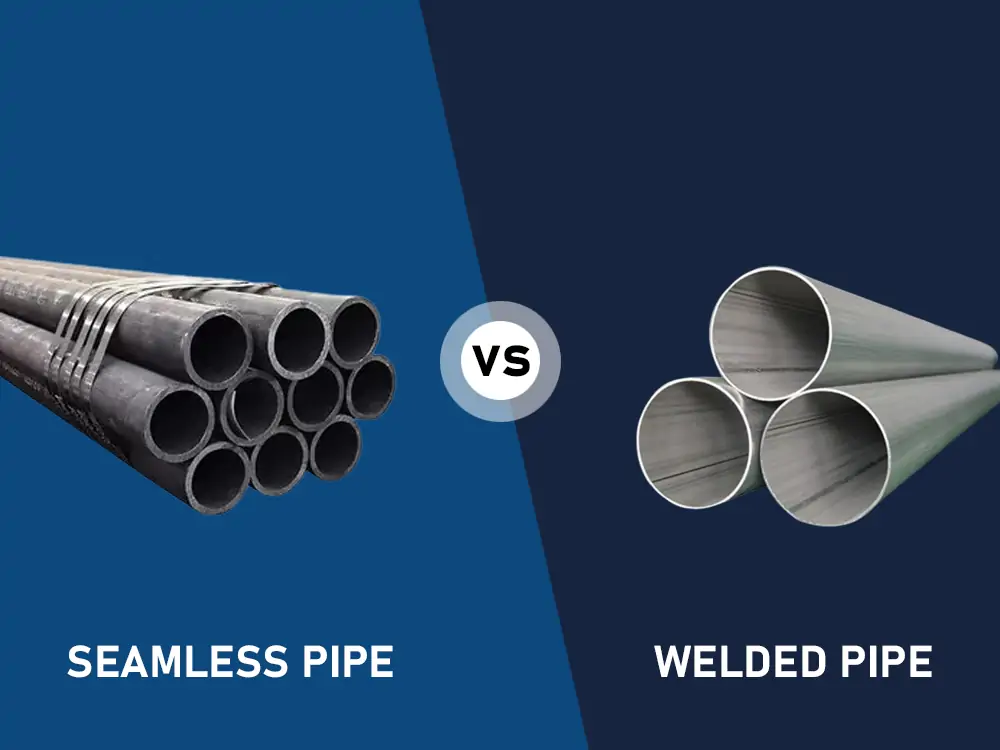
산업 현장에서 사용되는 강관은 이음매 없는 강관과 이음매가 있는 강관의 두 가지 범주로 나뉩니다. 어떤 것이 가장 적합한지 평가하려면 두 가지의 차이점을 이해하는 것이 필수적입니다.
심리스 강관 개요

원활한 파이프 용접보다 더 강하고 신뢰할 수 있는 것으로 간주됩니다. 파이프 균일한 구조와 부재로 인해 의 용접 또는 조인트.
이름에서 짐작할 수 있듯이 이음매 없는 강관은 용접 이음새가 없습니다. 심리스 파이프를 만들기 위한 주요 원자재는 강재 빌릿입니다. 빌릿은 피어싱 도구를 사용하여 천공되어 이음새가 없는 강관이 됩니다. 이 파이프는 직선형이며 용접된 모서리나 각도가 없습니다. 심리스 강관은 열간 압연, 냉간 압연 또는 냉간 인발로 제조됩니다. 심리스 강관은 굽힘 및 비틀림 강도가 우수합니다. 이러한 이유로 고압 애플리케이션에서 많이 사용됩니다. 석유 굴착 파이프, 자동차 구동축, 화학 플랜트 및 건설 지원 구조물 등을 구성합니다.
심리스 강관 개요

시임 강관은 용접 강관이라고도 합니다. 강철 스트립 또는 플레이트가 주요 원자재입니다. 일반적으로 둥글고 물/석유/가스 운송에서 흔히 볼 수 있기 때문입니다. 몸체를 따라 세로로 용접 이음새가 있습니다. 후처리를 하면 이 이음새는 거의 보이지 않습니다. 제조 과정에서 롤러는 강판을 원통형 모양으로 성형합니다. ERW 또는 SAW 공정을 통해 끝단을 부착하기 위해 용접이 수행됩니다. 용접 후 처리는 파이프의 치수가 정확하고 강도 요구 사항을 충족하도록 보장합니다. 시임 강관은 주로 수도, 석유, 가스 또는 하수관에 사용됩니다. 주로 건설 업계에서 볼 수 있습니다.
이음매 없는 강관과 이음매 있는 강관의 차이점
생산 프로세스
심리스 파이프는 빌렛 압출 및 압연으로 만들어지는 반면, 심 파이프는 강판을 용접으로 접합하여 만들어집니다. 생산 공정이 다르기 때문에 서로 다른 특성을 가지고 있습니다. 예를 들어 용접 강관에는 실리콘, 황, 망간이 포함되어 있습니다. 이러한 요소는 용접 성능을 향상시킵니다. 그러나 이음매 없는 강관에는 이러한 성분이 없습니다. 또한 이음매 없는 강관의 생산 공정이 까다롭기 때문에 ASTM에서는 이음매 있는 강관보다 벽 두께의 불규칙성이 더 넓게 허용합니다.
구조 및 성능
빌렛 천공 시 강철 공구가 관통하기 때문에 이음매 없는 파이프는 편심도가 더 높습니다. 용접 강관은 인발 및 압연 강판으로 만들어져 더 높은 두께 정밀도를 제공합니다. 심리스 강관은 심 파이프보다 인장 강도가 더 높지만 용접 용도로는 적합하지 않습니다. 벽이 두꺼운 심리스 파이프와 벽이 얇은 심리스 파이프를 생산하는 것이 더 쉽습니다.
비용 및 효율성
심리스 강관 제조는 심 강관보다 까다롭습니다. 단일 길이로 제작되기 때문에 조립이 고정된 크기로 이루어져야 하고 느리게 작동해야 합니다. 심리스 강관은 용접 강관보다 두께가 더 두껍기 때문에 생산 비용과 시간이 더 많이 듭니다. 이러한 요인으로 인해 이음매없는 파이프는 이음매가있는 파이프보다 두 배 더 비쌉니다.
외관 및 정밀도
이 두 파이프의 주요 차이점 중 하나는 용접 이음새입니다. 이음매가 있는 파이프의 내벽을 살펴보면 세로 용접 이음새를 발견할 수 있습니다. 이음매없는 강관의 경우에는 없습니다. 또한 심리스 파이프는 일반적으로 심이 있는 파이프보다 두껍고 넓습니다.
적용 가능한 환경
강관을 배치할 환경을 파악하면 최적의 합금 구성을 파악할 수 있습니다. 그러나 성능은 크게 다르지 않습니다. 심리스 강관은 일반적으로 벽 두께와 외경이 더 큽니다. 따라서 석유 및 가스 파이프 네트워크에 이상적입니다. 산업 기계의 구조 부품 역할을 합니다. 심이 있는 강관은 저압 애플리케이션에 더 적합합니다. 매우 다재다능하며 각도와 굴곡이 있는 파이프 라인에 적합합니다. 이러한 이유로 가정용 파이프 라인, 화학 공장, 수처리 시설 등에 사용됩니다.
결론
이음매 없는 강관과 이음매 있는 강관의 서로 다른 특성에 따라 적용 시나리오가 크게 달라집니다. 프로젝트에 사용할 파이프에 투자하기 전에 각 파이프의 고유한 특성을 염두에 두어야 합니다. 가정용 상수도 공급을 계획 중이신가요? 용접 강관이 적합할 것입니다. 넓은 땅에 가스 파이프라인을 설치하시나요? 심리스 강관을 고려해보세요. 강관에 관해 궁금한 점이 있으면 다음 연락처로 문의해 주세요. 문의하기. 파이프 선택을 기꺼이 도와드리겠습니다.
